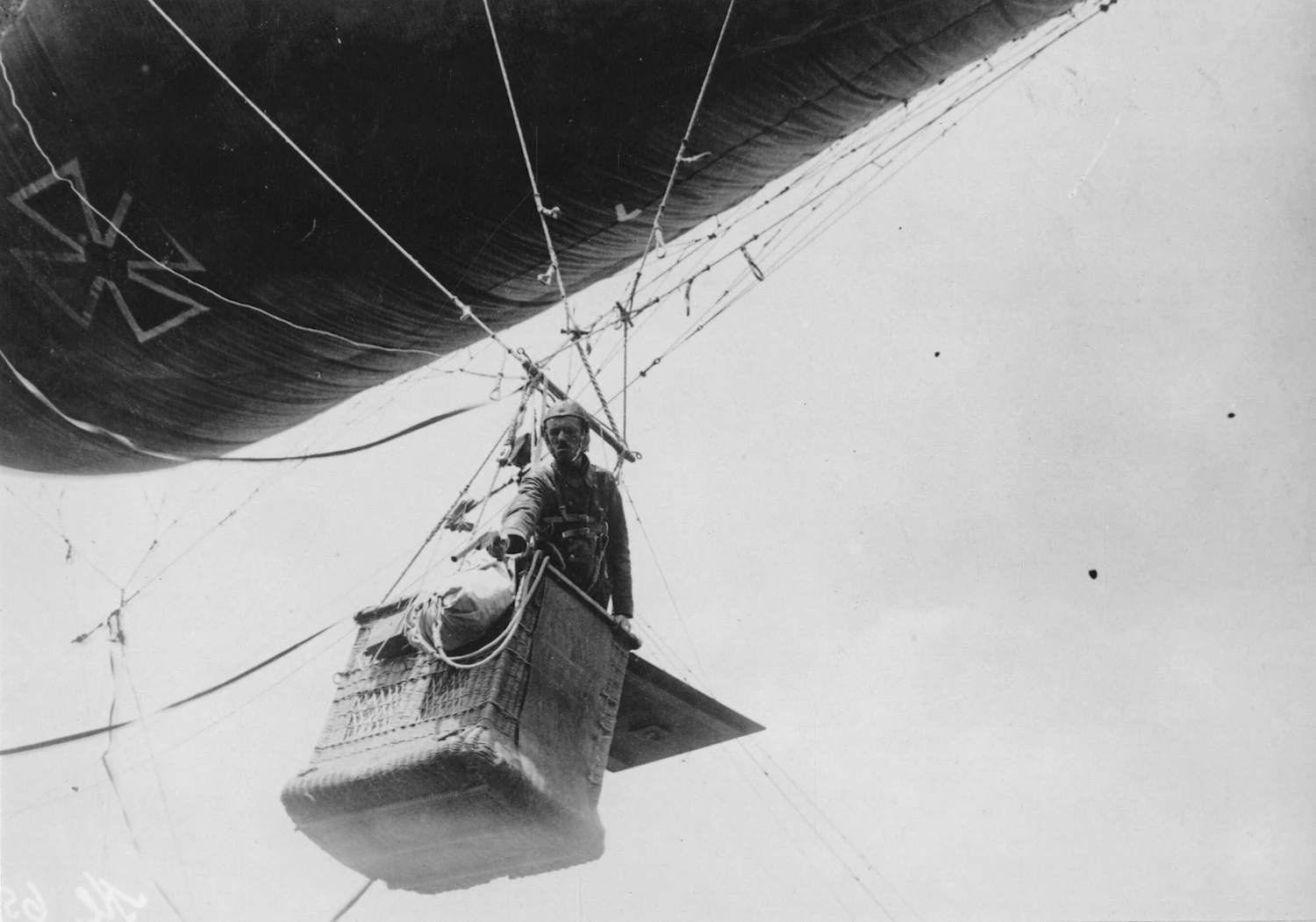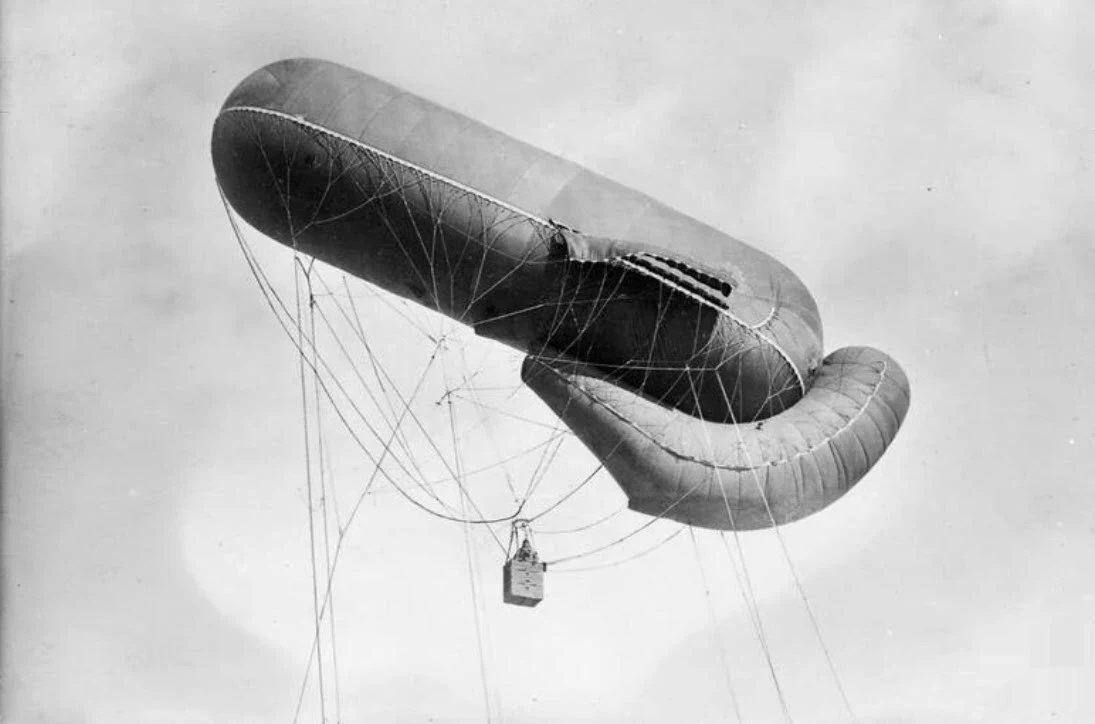"The flying sausage" or "Pigs do fly!" - Pig Model's Parsival-Sigsfeld German "Drachen" Observation Balloon in 1/144th scale preview...
Parsival-Sigsfeld German "Drachen" Observation Balloon
by Pig Model
1/144th scale
Kit Code: #PIG144-003
Price: $47USD from Hobbylink Japan at this link
The Subject: The Parseval-Sigsfeld Drachenballon
The German Empire's balloon corps formed after seeing the success of observation balloons in the American Civil War. Like the rest of the world, they too would use the simple spherical balloon type until the 1890s. In the early 1890s, two German officials; Major August von Parseval and Captain H Bartsch Von Sigsfeld began working together to create a new type of balloon to address the problems associated with spherical balloons.
Austro-Hungarian Drachenballon in 1917
Parseval and Sigsfeld would use the knowledge gained from these past attempts to develop their own replacement. Testing of the new type began in 1893. Many shapes, sizes and layouts were tested over several years, until in 1898, the final design for their observation balloon was completed. The new design was named the Drachenballon, literally ‘kite balloon,’ as it would glide with the wind, with the German spelling ‘ballon.’ The balloon was designed in such a way that it would face into the wind, instead of being blown around by it. Balloons designed in this way would, from then on, be called kite balloons.
Two German Drachenballons in different colours. The closest is painted green while the background is tan. The tan balloon’s ballonet isn’t inflated yet.
The Drachenballon would mostly serve as a captive balloon, or one that was connected to the ground via a cable. With the design proving to be a major improvement over the old spherical balloons, mass production soon commenced. Production of the type initially began at the August Riedinger plant in Augsburg, Germany. Here the balloons would be produced as well as the vehicles necessary to transport and support the balloons. The type quickly became the mainstay for the German Military for aerial observation duties, both by the German Army and the German Navy. For the Navy, Drachenballons would be carried aboard large warships and sent up for range-finding and battle observation. Despite being superior to the spherical balloons, the two types were still used together in balloon companies until the early 1900s when the Drachenballon completely replaced the older spherical type.
Two USSR operated balloons in Red Square during a celebration, 1920. The foreground balloon appears to be a Caquot-type with its upper fins deflated while the background is a Drachenballon.
The basket of the Drachenballon was made of willow and bamboo and was secured to the balloon by four ropes. These ropes were adjustable by the crew to prevent the basket from swinging around. Accommodations for the observer were located in the basket. A telephone could be placed in the basket and would have its cable connected to the ground via an internal wire that went through the mooring cable. Two pockets were located inside the basket to store equipment, as well as ten metal cases to protect valuable reports. Once a report was finished, it was put into a case and dropped from the balloon to the ground. Flags were put on the cases to help the ground crew find them more easily. Standard operating height for captive observation balloons were 500m, but if the weather was rough, the balloon would be raised to 300m instead. The larger Drachenballon variants created during the First World War would be able to achieve a maximum height of 2,000 meters. Inflation of the balloon would take 15 minutes, with ascension taking 10 minutes and descent taking 5 minutes.
The Drachenballon would be used for observation of enemy troop positions and movements, and would report on the current situation of the battle. Gun sighting and fire correction were also reported during battle to adjust the accuracy of artillery used near the balloon. Aboard ships, the Drachenballon was used for range-finding purposes. During the First World War, submarine spotting was an additional duty naval Drachenballons were used for.
Drachenballons of the German Army were standard tan or dark green. On the sides and on the underside was an Iron Cross emblem to identify its operator. Allied countries would not have these emblems on their balloons and their exact colours are unknown.
The Drachenballon would see its first operational use in wartime in 1904 during the Russo-Japanese war. Imperial Russia had acquired several Drachenballons from Germany around the outbreak of the war. The first battle Drachenballons would be used in would be the Battle of Port Arthur. In 1909, Sweden would purchase five Drachenballons from Germany to use for their military. The type would be named the Drakballong m/09. In 1909, Spain would use a Drachenballon they built from purchased plans during the Campaign of Millela. In 1912, the Italians would use the Drachenballon during the Italian-Turkish War for observing Turkish positions. Italian Drachenballons would also be used during their involvement in the First Balkan War. Aside from Italy, Bulgaria would also use Drachenballons during this war.
On the fronts in WWI, the Drachenballons were used as observation balloons and for range-finding for artillery. Each balloon company would be its own division in the army it was attached to. By the end of 1915, over 80 Drachenballons were in service with the German Army. The Austria-Hungarian Navy would also use Drachenballons aboard ships. German Drachenballons saw mass deployment during the Battle of the Verdun in February 1916, directing the large number of artillery regiment on the German side. Due to their success at Verdun, more balloon divisions were formed.
A Swiss-operated Drachenballon before lift-off around the time of the First World War
The shape of the Drachenballon became iconic in World War One, earning itself many nicknames. The most common was “Sausage” in reference to its overall shape, and maybe its German origin. Many other nicknames were spawned from its overall shape, most of them phallic references. Overall, Allied countries would simply refer to them as kite balloons or shorten the name to just “Drachen”
America at some point would acquire or build their own versions of Drachenballons, however they also had their own kite balloon design. Ralph H. Upson, a balloon pioneer and engineer at Goodyear, designed his own improved kite balloon based on the Drachenballon. No evidence has been found that America’s Drachenballons were used in the First World War. By the time of their entry in the war, more advanced types had already been fielded, and the remaining Drachenballons would be used for training of the various balloon corps.
Variants
Parseval-Sigsfeld Drachenballon – The standard Parseval-Sigsfeld Drachenballon came in several volumes/sizes, but all retained the same shape and overall design.
Copied Drachenballon – The Drachenballon was copied by several countries without license. The designs of these copies may be consistent with the German design, but some of these appear with details differing from the German version. The American “Old Dutch” Balloon appears to be one such example.
Ballon Captif Type H – French-built Drachenballons were given this designation.
Drakballong m/09 – Name given to five Drachenballons bought by Sweden.
The Kit: Pig Model's new 1/144th scale Parsival-Sigsfeld German "Drachen" Observation Balloon
Although only in 1/144th scale, this new plastic and photo-etched kit from Pig Model is going to be 16.2cm long and 14.7cm high when constructed. The stand included is strong enough to hold the balloon aloft in the air after you have made the kit...
We don't often use cats for scale comparison. But there is a first time for everything!
The parts of the kit, two plastic halves, a stand and photo-etched parts pre-rigged (as much as they can be before making the kit). the stand bears the model's weight while the rigging stays free.
The instructions showing the easy construction and the painting markings
You can see where this airship got its colourful nicknames from when you see the shape and spongy look of the air-sacks!
You can see the delicate rigging is easy to glue to the plastic and the weight of the kit is taken by the stand. Quite smartly done we think.A smart and interesting subject for any WWI or turn of last century civilian modeller, we would think!
This model is already available n shops, we found it at $47USD from Hobbylink Japan.
You can find out more about this kit from Pig Models Facebook page.
You can find out more about this balloon on the Plane Encyclopedia page....



.jpg)









.jpg)
.jpg)
.jpg)
.jpg)
.jpg)
.jpg)
.jpg)
